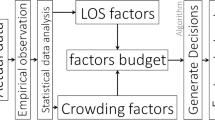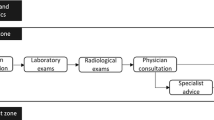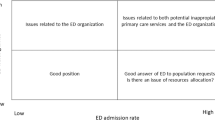Abstract
Emergency department overcrowding has been reported over decades around the globe and the phenomenon is observed to be worsening in recent years. The overcrowding issue will hinder critically-ill patients from accessing timely and adequate medical services, and may result in unnecessary deaths of emergency patients. Furthermore, it may lead to patient dissatisfaction due to the many hours of waiting for consultation. While most studies suggest that there is a mismatch between demand and supply for emergency care and this is the primary factor for the phenomenon, reducing system inefficiency is a possible way to relieve the overcrowding situation when the demand and supply are not adjustable. In this paper, we study the impacts of missing patients, referring to the patients who are not present at the time that they are called for consultation. We conduct a real case study and a simulation study of an emergency department in Hong Kong. We found that even if there is only a small proportion of missing patients and their missing time is short, there is a significant increase in patient waiting time. We suggest that emergency departments should consider to adopt information technology to reduce the inefficiency due to missing patients.
Access this chapter
Tax calculation will be finalised at checkout
Purchases are for personal use only
Similar content being viewed by others
References
Ahmed, M.A., Alkhamis, T.M.: Simulation optimization for an emergency department healthcare unit in Kuwait. Eur. J. Oper. Res. 198 (3), 936–942 (2009)
American College of Emergency Physicians. Efficiency in the Emergency Department: Doing things faster without sacrificing quality. ACEP Reference and Resource Guide (2004)
Australasian College for Emergency Medicine: Policy document — standard terminology. Emerg. Med. 14, 337–340 (2002)
Baesler, F.F., Jahnsen, H.E., DaCosta, M.: The use of simulation and design of experiments for estimating maximum capacity in an emergency room. In: Proceedings of the 2003 Winter Simulation Conference, pp. 1903–1906 (2003)
Brailsford, S.C., Harper, P.R., Patel, B., Pitt, M.: Analysis of the academic literature on simulation and modelling in health care. J. Simul. 3, 130–140 (2009)
Chung, C.H.: Emergency department misuse and administrative interventions. Hong Kong J. Emerg. Med. 7 (4), 220–229 (2000)
Cochran, J.K., Roche, K.T.: A multi-class queuing network analysis methodology for improving hospital emergency department performance. Comput. Oper. Res. 36 (5), 1497–1512 (2009)
Connelly, L.G., Bair, A.E.: Discrete event simulation of emergency department activity: a platform for system-level operations research. Acad. Emerg. Med. 11 (11), 1177–1185 (2004)
Cowan, R.M., Trzeciak, S.: Clinical review: emergency department overcrowding and the potential impact on the critically ill. Crit. Care 9 (3), 291–295 (2005)
Derlet, R.W., Richards, J.R.: Overcrowding in the nation’s emergency departments: complex causes and disturbing effects. Ann. Emerg. Med. 35 (1), 63–68 (2000)
Derlet, R.W., Richards, J.R., Kravitz, R.L.: Frequent overcrowding in US emergency departments. Acad. Emerg. Med. 8 (2), 151–155 (2001)
Fetter, R.B., Thompson, J.D.: The simulation of hospital systems. Oper. Res. 13 (5), 689–711 (1965)
Gallagher, E.J., Lynn, S.G.: The etiology of medical gridlock: causes of emergency department overcrowding in New York City. J. Emerg. Med. 8 (6), 785–790 (1990)
Günal, M.M., Pidd, M.: Discrete event simulation for performance modelling in health care: a review of the literature. J. Simul. 4 (1), 42–51 (2010)
Green, L.V., Soares, J., Giglio, J.F., Green, R.A.: Using queueing theory to increase the effectiveness of emergency department provider staffing. Acad. Emerg. Med. 13 (1), 61–68 (2008)
Hing, E., Bhuiya, F.A.: Wait Time for Treatment in Hospital Emergency Departments, 2009. US Department of Health and Human Services, Centers for Disease Control and Prevention, National Center for Health Statistics (2012)
Hoot, N.R., Aronsky, D.: Systematic review of emergency department crowding: causes, effects, and solutions. Ann. Emerg. Med. 52 (2), 126–136 (2008)
Hoot, N.R., LeBlanc, L.J., Jones, I., Levin, S.R., Zhou, C., Gadd, C.S., Aronsky, D.: Forecasting emergency department crowding: a discrete event simulation. Ann. Emerg. Med. 52(5), 116–125 (2008)
Horwitz, L.I., Bradley, E.H.: Percentage of US emergency department patients seen within the recommended triage time: 1997 to 2006. Arch. Intern. Med. 169 (20), 1857–1865 (2009)
Huang, Y.C., Chu, C.P., Lin, Y.S., Kuo, C.H.: RFID Applications in Hospitals—A Case Study for Emergency Department (2010)
Hulshof, P.J., Kortbeek, N., Boucherie, R.J., Hans, E.W., Bakker, P.J.: Taxonomic classification of planning decisions in health care: a structured review of the state of the art in OR/MS. Health Syst. 1 (2), 129–175 (2012)
Hwang, U., McCarthy, M.L., Aronsky, D., Asplin, B., Crane, P.W., Craven, C.K., Epstein, S.K., Fee, C., Handal, D.A., Pines, J.M., Rathlev, N.K., Schafermeyer, R.W., Zwemer, F.L., Bernstein, S.L.: Measures of crowding in the emergency department: a systematic review. Acad. Emerg. Med. 18 (5), 527–538 (2011)
Jahangirian, M., Naseer, A., Stergioulas, L., Young, T., Eldabi, T., Brailsford, S., Patel, B., Harper, P.: Simulation in health-care: lessons from other sectors. Oper. Res. 12, 45–55 (2012)
Jun, J.B., Jacobson, S.H., Swisher, J.R.: Application of discrete-event simulation in health care clinics: a survey. J. Oper. Res. Soc. 50 (2), 109–123 (1999)
Kuo, Y.H., Rado, O., Lupia, B., Leung, J.M., Graham, C.A.: Improving the efficiency of a hospital emergency department: a simulation study with indirectly imputed service-time distributions. Flex. Serv. Manuf. J. 28 (1), 120–147 (2016)
Lane, D.C., Monefeldt, C., Rosenhead, J.V.: Looking in the wrong place for healthcare improvements: a system dynamics study of an accident and emergency department. J. Oper. Res. Soc. 51 (5), 518–531 (2000)
Mayhew, L., Smith, D.: Using queuing theory to analyse the Government’s 4-h completion time target in accident and emergency departments. Health Care Manag. Sci. 11 (1), 11–21 (2008)
Miro, O., Antonio, M.T., Jimenez, S., De Dios, A., Sanchez, M., Borras, A., Milla, J.: Decreased health care quality associated with emergency department overcrowding. Eur. J. Emerg. Med. 6 (2), 105–107 (1999)
Pérez, M.M., Cabrero-Canosa, M., Hermida, J.V., García, L.C., Gómez, D.L., González, G.V., Herranz, I.M.: Application of RFID technology in patient tracking and medication traceability in emergency care. J. Med. Syst. 36 (6), 3983–3993 (2012)
Rado, O., Lupia, B., Leung, J.M., Kuo, Y.H., Graham, C.A.: Using simulation to analyze patient flows in a hospital emergency department in Hong Kong. In: Proceedings of the International Conference on Health Care Systems Engineering, pp. 289–301 (2014)
Rainer, T.: Why are Hong Kong’s emergency departments so understaffed? Emerg. Physicians Int. 11, 26–27 (2013)
Rais, A., Viana, A.: Operations research in healthcare: a survey. Int. Trans. Oper. Res. 18 (1), 1–31 (2011)
Richardson, L.D., Hwang, U.: Access to care a review of the emergency medicine literature. Acad. Emerg. Med. 8 (11), 1030–1036 (2001)
Rossetti, M.D., Trzcinski, G.F., Syverud, S.A.: Emergency department simulation and determination of optimal attending physician staffing schedules. In: Proceedings of the 1999 Winter Simulation Conference, pp. 1532–1240 (1999)
Saghafian, S., Hopp, W.J., Van Oyen, M.P., Desmond, J.S., Kronick, S.L.: Patient streaming as a mechanism for improving responsiveness in emergency departments. Oper. Res. 60 (5), 1080–1097 (2012)
Shih, F.Y., Huel-Ming, M., Chen, S.C., Wang, H.P., Fang, C.C., Shyu, R.S., Huang, G.T., Wang, S.M.: ED overcrowding in Taiwan: facts and strategies. Am. J. Emerg. Med. 17 (2), 198–202 (1999)
Turner, J., Mehrotra, S., Daskin, M.S.: Perspectives on health-care resource management problems. In: A Long View of Research and Practice in Operations Research and Management Science, pp. 231–247 (2010)
United Christian Hospital (2014): DREAMS. http://www3.ha.org.hk/uch/hospital/show.asp?c=spIQDS Accessed 16 February 2015
Acknowledgements
The research of the first author is supported by Microsoft Research Asia Collaborative Research Fund FY15-RES-THEME-049 and Macao Science and Technology Development Fund 088/2013/A3. The research of the second author is partially supported by GRF grant 414313 from the Hong Kong Research Grant Council. The authors would also like to thank Mr. Stones Wong, Operations Manager of the Emergency Department of the Prince of Wales Hospital, for his assistance in data collection.
Author information
Authors and Affiliations
Corresponding author
Editor information
Editors and Affiliations
Rights and permissions
Copyright information
© 2016 Springer International Publishing Switzerland
About this paper
Cite this paper
Kuo, YH., Leung, J.M.Y., Graham, C.A. (2016). How Do Missing Patients Aggravate Emergency Department Overcrowding? A Real Case and a Simulation Study. In: Matta, A., Sahin, E., Li, J., Guinet, A., Vandaele, N. (eds) Health Care Systems Engineering for Scientists and Practitioners. Springer Proceedings in Mathematics & Statistics, vol 169. Springer, Cham. https://doi.org/10.1007/978-3-319-35132-2_16
Download citation
DOI: https://doi.org/10.1007/978-3-319-35132-2_16
Published:
Publisher Name: Springer, Cham
Print ISBN: 978-3-319-35130-8
Online ISBN: 978-3-319-35132-2
eBook Packages: Mathematics and StatisticsMathematics and Statistics (R0)




